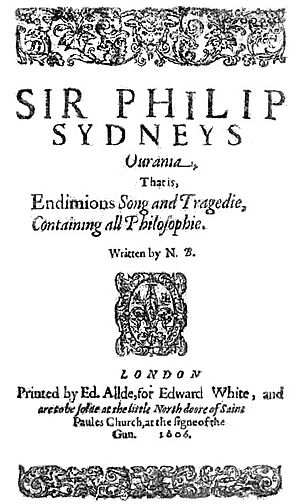Nathaniel Baxter facts for kids
Nathaniel Baxter was an English clergyman and poet who lived around the early 1600s. He is mainly remembered for his poem Ourania, which was published in 1606. Earlier in his life, he was a teacher (tutor) to the famous Sir Philip Sidney. Baxter was interested in literature and a type of logic called Ramist logic, but as he got older, he became more focused on his religious beliefs.
Baxter's Life Journey
Nathaniel Baxter taught Greek to Sir Philip Sidney. He studied at Magdalen College, Oxford in 1569 and earned his Master of Arts degree in 1577. He also traveled around Europe between 1575 and 1577 with Edward de Vere, 17th Earl of Oxford. Baxter mentioned de Vere in his poem Ourania. He also wrote about de Vere's daughter, Susan, who married Philip Herbert, 4th Earl of Pembroke.
Baxter held several church positions (clerical positions) in different places. These included Redbourn in Hertfordshire, Finedon and Titchmarsh in Northamptonshire, and Leire in Leicestershire. He also worked at churches in London, such as St. Margaret Lothbury and St. Giles-in-the-Fields in 1590. Baxter was one of the people who signed an important letter to Thomas Cartwright in London on May 25, 1577.
Time in Ireland
In 1592, Baxter became the warden of Collegiate Church of St Mary Youghal in Ireland. He officially started this job on May 23, 1592. However, by August 25, 1597, the money coming into the college (revenues) was in trouble. Baxter had to agree that he would leave his job if asked.
Later, on April 26, 1598, a complaint was made that Baxter refused to let officials take control of the college's money. He was ordered to appear in court. On June 30, 1598, Baxter gave away the college's money and house to Sir Thomas Norris. After this, Baxter resigned from his position. However, the officials refused to accept this, as the money was gone. Baxter left Ireland in 1599.
After leaving Ireland, Baxter became the vicar of Mitchel Troy in Monmouthshire. He started this new role on May 26, 1602. In 1633, he was involved in a discussion with John Downes, who was a theologian (someone who studies religion) from Bristol.
Baxter's Writings
Joseph Hunter, a historian, believed that Nathaniel Baxter wrote Ourania. This poem was sometimes thought to be written by someone else, Nicholas Breton. Ourania talks about Baxter's time teaching Sir Philip Sidney. It also includes details about Baxter's life and his house in Troy. Sidney even gave Baxter a playful nickname, 'Tergaster', which is a Latin joke meaning 'Back-ter' or 'Bax-ter'. The poem also includes compliments to important ladies and gentlemen of the time.
Baxter also wrote several religious books. Some of these included:
- A Soneraigne Salue for a Sinful Soule: This book explained how a person could find peace with God. It also listed many names or titles for the Son of God found in the Bible.
- Calvin's Lectures or Daily Sermons upon the Prophet Jonas: Baxter translated these sermons by John Calvin into English. One edition was dedicated to Sir John Brocket in 1578. Another edition was dedicated to Sir Francis Walsingham on January 22, 1577.
- A Catholique and Ecclesiastical position of the last Epistle of John: This book was a collection of writings about the last letter of John from the Bible. Baxter gathered it from the works of important writers like Augustine Marlorat. He dedicated this book to Lady Walsingham in 1578.
Baxter also wrote a book about logic called D. Nathaniaelis Baxteri Colcestrensis queastiones et responsa in Petri Ranii [i.e. Rami] dialecticam. It was published in London in 1586.


